Achieving Design Objectives with Metal Roofs and Facades
How seven projects met performance, sustainability, and aesthetic goals with metal cladding
![]() Continuing Education
Continuing Education
Use the following learning objectives to focus your study while reading this month’s Continuing Education article.
Learning Objectives - After reading this article, you will be able to:
- Define what a cool roof is and how it impacts the efficiency of a building by managing solar radiation and minimizing the amount of heat that transfers through the roof and into the interior.
- Explain how a metal roof enhances solar panel performance and supports rainwater harvesting.
- List the specific credits in LEED v4 that a metal roof can contribute toward earning.
- Explore how metal panels can be used to create distinct architectural elements, such as curved roofs, perforated walls, mosaics, and continuous lines from the roof to the wall.
There is so much to consider about the materials that are ultimately selected for the roof or cladding of a project. How does it perform? How long until it will need to be replaced? What sustainability benefits does it offer? Can designers use it in a number of ways to achieve the desired aesthetic? Metal is a material that is uniquely equipped to deliver desirable solutions in terms of performance, sustainability, and creative license.
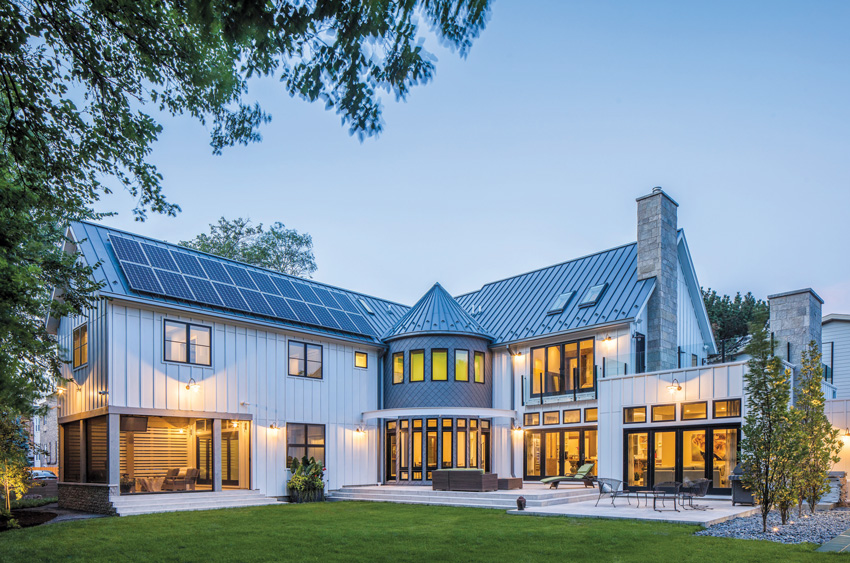
Photo: A.J. Brown
This striking and sustainable Chicago residence, designed by Nate Kipnis, features a standing-seam metal roof that helps create the desired farmhouse aesthetic and contributes toward the efficient performance of the home.
While the benefits of using metal on a roof or as cladding—its longevity, durability, impressive strength-to-weight ratio, recyclability, and variety of finishes— are well known to many, designers often learn a lot by seeing how the material has been applied in different types of projects. This course will profile seven different building envelopes that feature either a metal roof or metal wall panels on the facade, and, in some cases, both. Thankfully, many of the designers who worked on these projects agreed to share their insights and provide context as to why they used metal in the ways that they did.
These projects range from a large residence in Chicago that features the latest in sustainability to museums and banks designed to be distinct and make a lasting impression. While these projects represent a wide cross-section of building types and design objectives, they all achieved their goals by incorporating metal into their roofs and/or facades.
A Large, Sustainable, Healthy Home in Chicago
An impressive residence built in the Horner Park neighborhood of Chicago showcases the latest techniques and products being used to create beautiful, energy-efficient, and highly sustainable structures in even the most challenging settings. This project was unique for many reasons. Firstly, the property spans five of the city’s standard 100-foot by 125-foot lots, making it unusually large. It is also located at the end of a dead-end street with a backyard that abuts the recently revitalized Chicago River, offering almost rural views across the river and into a 57-acre city park from a very urban zip-code.
“The owners wanted a highly sustainable home that created a healthy environment for their family,” explains architect Nate Kipnis, FAIA, of Kipnis Architecture + Planning. Another design goal was to make the home feel as peaceful as possible by making the most of the views available through the windows, without distorting the neighborhood feel. In order to maximize the beautiful views and maintain the scale of the neighborhood, the front of this L-shaped house was purposefully designed to be the same proportion as the neighboring homes, with the tail of the house being somewhat hidden as it stretches toward the river at the end of the dead-end street. The shape of the structure also helps to block noise from a major street that is just two blocks away. “There isn’t a site in Chicago like this,” Kipnis explains, “where you live in the middle of a city and don’t see a building.”
As for creating the highly sustainable, healthy, suburban-scale home in Chicago, Kipnis is uniquely equipped for the challenge as the national co-chair of the American Institute of Architects (AIA) 2030 Commitment Working Group. The final project contains more than 75 unique and sustainable features, which ultimately resulted in the creation of a house that is over 50 percent more efficient than a comparable home designed to the ASHRAE 90.1 2003 baseline standard.
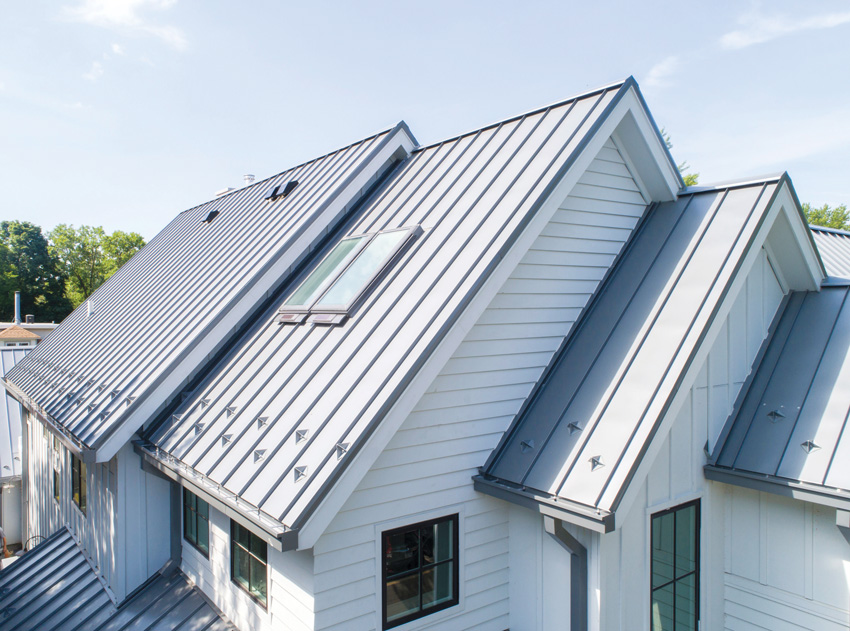
Photo: A.J. Brown
Cool-roof technology causes a surface to reflect more sunlight and absorb less heat than a standard roof, reducing heat gain that occurs inside the home and keeping local outside air cooler.
A quick review of some of those sustainability-enhancing features includes south-facing solar photovoltaic panels that provide 26 percent of the total energy use. The appliances that typically use natural gas (the water heater, cooktop, and dryer) are now high-efficiency electric appliances. The mechanical system is an air-source heat pump that extracts heat out of the air, even when temperatures reach -20 degrees Fahrenheit. Electricity use was also reduced by providing sufficient levels of daylight throughout the house with skylights and Solatubes so that the interior is very comfortable without turning the LED lights on when daylight is present.
Beyond using less energy, the house has been designed not to leak. It is air-tight and highly insulated. The continuous foam insulation selected for the exterior of the wall system limits thermal transfer and supports the efficiency of the HVAC system.
Although fireplaces are not typically found in highly efficient homes, the fireplaces chosen for this project use outside combustion air to burn the wood. This is a more sustainable approach because the conditioned air is not consumed by the fire. This system also uses a glass door to separate the conditioned interior air from the air in the fireplace that is going up the flue. This type of product allowed the team to deliver that comfortable-home feeling without compromising the performance of the project.
The materials were also carefully selected with sustainability criteria in mind. The siding is cement fiberboard made from waste wood and cement. Many of the materials are from local sources or recycled. The underside of the soffits and the ceiling in the screened porch feature local reclaimed barn wood. The standing-seam metal roof helped achieve the farmhouse aesthetic that the clients wanted while contributing toward the overall sustainability of the project in many ways.
A Sustainability-Supporting Cool Metal Roof
A roof receives an incredible amount of sunlight exposure day after day. A cool roof is defined as a roof that reflects more sunlight and absorbs less heat than a standard roof. Consider that a flat roof in the midday sun receives about 1,000 watts of sunlight per square meter. A dark roof will absorb most of this energy, heating the roof, the interior space contained underneath it, and even causing the temperature of the local air outside of the structure to rise, contributing to the urban heat island effect. A cool roof can be engineered to reflect most of the visible light as well as light in the infrared spectrum that hits it, which can dramatically reduce the temperature the surface reaches, even underneath the blazing sun.
According to the Department of Energy (DOE), standard or dark roofs can reach temperatures of 150 degrees Fahrenheit or more in the summer. A cool roof, under the same conditions, could stay more than 50 degrees cooler. This lower temperature delivers important benefits. A cool roof will reduce the heat gain that occurs inside the home, which decreases the load on the air-conditioning unit, ultimately reducing the amount of energy and money that must be consumed to keep the interior cool and comfortable. It also reduces the air temperatures reached above the cool roof, combatting the urban heat island effect that further exacerbates hot times and summer in a city.
In the article, “Cool roofs: beating the midday sun with a slap of white paint,” written by Dyani Lewis and published in The Guardian, sustainable construction expert Chris Jensen from the University of Melbourne explains, “On a black tile roof, you could fry an egg. On a cool roof, you could walk on it in your bare feet. That’s the magnitude of the difference.”
Cool roofs can be constructed from highly reflective shingles or roofing materials coated in a highly reflective paint. “From a sustainability perspective, we always want a roof to be cool instead of hot,” Kipnis explains. “A cool roof dramatically impacts the way that a home manages the sun’s heat and the amount of heat that transfers into the interior of the home and then must be cooled.”
The way that a cool metal roof manages the light and heat-causing infrared radiation in direct sunlight is described by three properties: solar reflectance, thermal emittance, and a solar-reflectance index value that considers both the solar reflectance and thermal emittance in concert. Solar reflectance indicates the percentage of sunlight that is reflected off the roof. Determined on a scale of 0 to 1, lower solar-reflectance values indicate that more energy is absorbed than reflected. For example, a reflectance value of 0.05 means that the surface reflects only 5 percent of the solar energy that strikes it and absorbs 95 percent. Thermal emittance characterizes a surface’s ability to re-radiate or re-emit previously absorbed heat away from itself. Also rated on a scale between 0 and 1, the higher the thermal emittance of an object, the better it is at emitting heat it has absorbed and remaining cool, even when direct sunlight is shining upon it.
The third metric, the solar-reflectance index (SRI) measures a constructed surface’s ability to stay cool in the sun by reflecting solar radiation and emitting thermal radiation. As the USGBC explains, “It is defined such that a standard black surface (initial solar reflectance 0.05, initial thermal emittance 0.90) has an initial SRI of 0, and a standard white surface (initial solar reflectance 0.80, initial thermal emittance 0.90) has an initial SRI of 100.” The SRI can be used as an indicator of how hot a surface is likely to become when solar radiation is incident upon it. The lower the SRI, the hotter the material is likely to become when exposed to the sun’s rays.
Kipnis designed this large, farmhouse-style house with a silo-like turret and an elaborate standing-seam metal roof painted with a cool-roof technology. The roof specified onto the Chicago residence was comprised of 8,500-square-foot panels of 24-gauge steel. The weathered zinc finish had a solar-reflectivity rating of 0.25, an emissivity rating of 0.82, and an SRI value of 22. With these solar-management metrics, the roof will stay cool during the hot summer months and protect the home against the formation of damaging ice dams during those formidable winters in the Second City.
“Hot roofs can create problems even when it’s cold outside,” Kipnis explains. “If there is snowfall on a roof and the roof captures a large amount of the solar energy beating upon it, the roof will warm up and melt the snow before the conditions for snowmelt exist, so the melted snow refreezes when it hits the overhang and an ice dam forms.”
An ice dam is a ridge of ice that forms at the edge of a roof and prevents melting snow from draining off the roof. Ice dams can be incredibly destructive to the house that hosts them, tearing off gutters, loosening shingles, and even allowing water to enter the interior, which then creates a myriad of problems from sagging ceilings, warped floors, and soggy insulation, which can then breed mold and mildew.
“Cool roofs prevent that premature thaw and simply maintain the snow cover until the seasonal conditions shift and naturally melt the snow. Then it drains away from the house just as it is designed to do,” Kipnis says. “Metal roofs also look great and support many other sustainability criteria far better than the asphalt, wood, or slate materials often used.”
Enhance Solar-Panel Performance
The standing-seam metal roof also provides an ideal surface to host solar arrays that further reduce the carbon footprint of a project. “If we are trying to put solar panels on an asphalt roof, there are a number of problems that can arise. Some installation methods will penetrate the roof in several areas in order to mount the solar panels. This obviously isn’t ideal,” Kipnis adds. “With a standing-seam metal roof, the solar panels can be clamped directly to the standing seams with S-5 clamps, without penetrating the surface of the roof. That’s a huge advantage.”

Photo: A.J. Brown
A cool standing-seam metal roof is an ideal surface to host solar arrays because the panels can be clamped directly to the seams without penetration and the panels remain cooler, which improves their performance.
Using a cool metal roof as a platform for the solar panels instead of a standard or dark roof can also improve the functionality of the solar panels. When the solar arrays are clamped to the standing-seam roof, the panels are raised up off of the metal surface, which allows air to circulate underneath them and helps to cool them off. As previously mentioned, the cool roof also stays cooler than a typical roof material. This is important because solar panels work best in cooler environments. Work by Jensen and his colleagues has shown that solar panels installed on a cool roof produce almost 7 percent more electricity on a typical day than those installed on a conventional roof.
Shed Cleaner Rainwater for Harvesting
The term rainwater harvesting refers to collecting the runoff from a roof and storing it for later use. Traditionally, rainwater runs off the roof and will collect in gutters that channel the water into downspouts and some type of storage vessel. Standing-seam metal roofs offer one of the best solutions for rainwater harvesting, as their collection efficiency is one of the highest of all popular roofing materials. Studies by the University of Texas and the Texas Water Development Board found that a standing-seam metal roof delivers a collection efficiency of up to 95 percent. In fact, less than a single inch of rain falling on a 10-foot by 10-foot standing-seam metal surface can produce 60 gallons of rainwater reserve. For context, it is estimated that clay tiles offer roughly an 85 percent collection efficiency because the tiles are porous and absorb a portion of the rain that strikes them.
Beyond the efficiency of the runoff that a roof can provide, the roofing material also impacts the quality of the water. For example, some roofing materials contain pollutants or other ingredients that could leach into the rainwater and contaminate it. A lot of corrugated material is galvanized, which will leach some zinc into the rainwater. Wood shingles are often treated with fire retardants, which probably isn’t a good additive for rainwater that will be reused. Copper is an herbicide, so if the end goal is to use the rainwater runoff for garden irrigation, a copper roof should be avoided. Many asphalt-shingle roofs, also called composition-shingle roofs, are installed using adhesives that can off-gas for up to three years after installation. For that reason, homeowners may want to avoid using rainwater harvested off of a new asphalt roof to irrigate anything that will be consumed for three years. Asphalt shingles can also release bits of gravel into the runoff, but those can be managed with an inlet screen on the collection tank. Standing-seam metal roofs are often recognized as a superior choice for creating efficient and high-quality rainwater-harvesting systems.
Recycled and Recyclable
“Metal is also a more environmentally friendly material to select for a roof,” Kipnis adds. “Although asphalt shingles are more commonly used, asphalt is a byproduct of crude-oil refining. The metal we used for the standing-seam roof contains recycled content and can be recycled at the end of its useful life, which addresses many of the materials-focused concerns that are an important part of green buildings.”
Steel and aluminum are 100 percent recyclable and can be milled with pre-consumer and post-consumer recycled content. In fact, the two contemporary processes used to produce new steel require old steel, and so steel inherently contains recycled content and is recognized as having a previously established industry average of 25 percent post-consumer recycled content. This means that incorporating steel products into a project can help to achieve recycled content thresholds without requiring the product-specific documentation often required.
In addition, green-building rating systems like LEED v4 now encourage the use of products and materials for which life-cycle information is available and that have favorable life-cycle impacts. Points are awarded for specifying materials into a project that disclose life-cycle assessments (LCAs) or make product-specific environmental product declarations (EPDs) available.
Leed-Silver-Certified Milton Library
The 25,000-square-foot state-of-the-art Milton Library earned a LEED Silver certification in 2016 and the prestigious 2016 Metro Atlanta Chamber of Commerce M3 Award for the Built Environment category. Designed by Stevens & Wilkinson of Atlanta in association with 720 Design of Dallas, the building reflects the equestrian and agrarian history of Georgia’s Fulton County with a distinctive farmhouse look that features a silo element that serves as the main entrance. The various forms in the design are capped with a roof that combines two gabled roof elements and a small membrane roof with a high and circular roof line above the silo, marking the entryway.
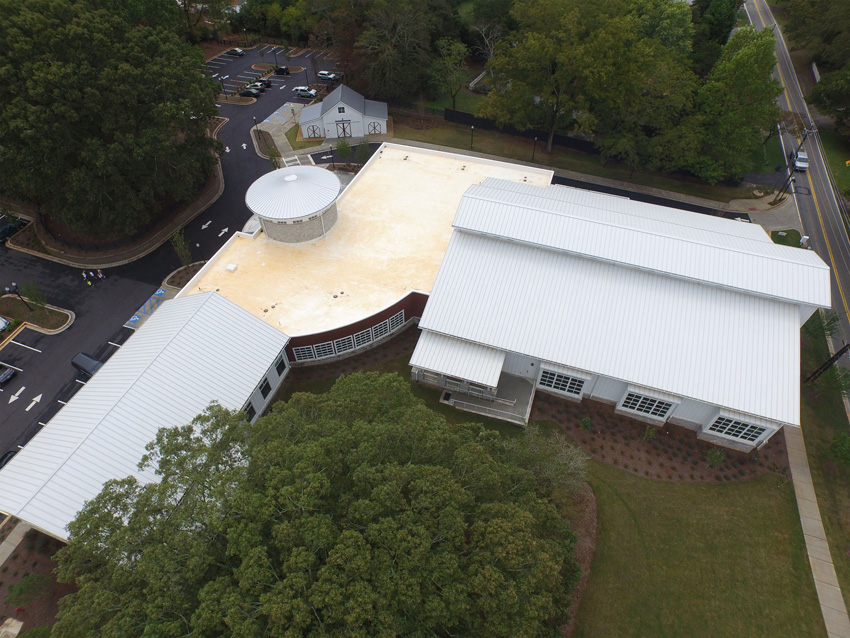
Photo: Courtesy of PAC-CLAD | Petersen
The cool standing-seam metal roof at the Milton Library, finished in stone white, helps to keep the interior comfortable, supports rainwater harvesting for improved water efficiency, and contains recycled content.
Creating a high-performance and energy-efficient building requires that the structure be equipped to manage solar radiation. The design of the Milton Library minimized solar heat gain with thoughtful orientation and a cool metal roof. The roof is constructed from two types of metal panels. The roof of the silo is clad with metal tapered panels, while standard metal panels are used on rest of the building.
Both are finished with a cool white coating that enhances the metal surface’s ability to reflect and re-emit the solar radiation that impact it. The reflectivity of the metal panels used on the Milton Library roof is 0.67, and the thermal emissivity value is 0.85, delivering a cool roof with an SRI value of 80. This ultimately keeps the building cooler and reduces the amount of energy that must be used to maintain a comfortable interior, even during the hot summer months in Georgia.
Water efficiency was also an important sustainability goal of the project, so low-flow plumbing fixtures were selected and xeriscaping was incorporated into the design. Xeriscape is a type of landscaping that features native, drought-resistant plants arranged in ways that are particularly water efficient. A properly xeriscaped lawn can reduce outdoor water use by 60 percent or more. The project also implemented a stormwater-management plan that reduced impervious hardscapes, promoting the infiltration of groundwater at the site and capturing stormwater runoff for reuse. The cool metal roof contributes toward water efficiency of the project by effectively shedding rainwater to be captured by the rainwater-harvesting system.
A lot of consideration was also given to the type of energy used on-site and materials selected for the project. The parking lot encourages carpooling and gives priority spaces to visitors who travel in low-emitting, fuel-efficient vehicles. The project also purchased a two-year renewable energy contract to offset more than 70 percent of the building’s energy use. Specifying materials with recycled content, such as a metal roof, also reduced the environmental impact of the project by decreasing the need for the extraction of virgin materials.
Metal Roofs Contribute toward LEED Points
Beyond supporting a wide variety of sustainability criteria, a metal roof can contribute toward earning specific credits in the LEED v4 green-building rating system. In the Sustainable Sites category, a metal roof can help a project satisfy the Heat Island Reduction credit and the Rainwater Management credit. In the Water Efficiency category, a metal roof can contribute toward achieving credits for reducing water use both indoors and outdoors. A metal roof can also help a project earn Optimize Energy Performance and Renewable Energy Production credits in the Energy & Atmosphere category. There are multiple credits in the Materials & Resources category that can be supported by the selection of a metal roof, including Building Life-Cycle Impact Reduction, Building Product Disclosure and Optimization, and Construction and Demolition Waste Management. The metal roof can also contribute toward earning the Thermal Comfort credit in the Indoor Environmental Quality category.
Distinct and Dramatic Exteriors
Whether using metal panels in the roof or facade of a project, the material enables designers to achieve distinct and dramatic exteriors that make an impression. From creating a continuous element that can run from the top to the bottom of a building, functioning as both roof and wall, to designing an unbroken horizontal line around the building, metal panels can be used to break the traditional box style. Curved roofs and perforated panels enable designers to redefine the form of a building, creating awe and engaging audiences with unique views into the structure. A broad palette of colors can be used to create bold mosaics that generate visual interest and appeal. Here are a few examples of how designers have used metal panels to create noteworthy and high-performance exteriors.
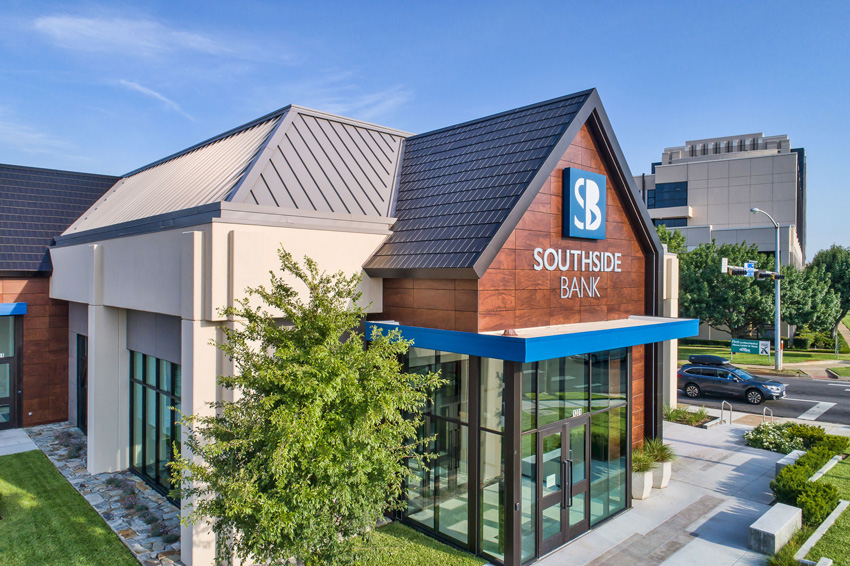
Photo: Tom Coplen
During the renovation of Southside Bank’s flagship branch, metal tiles and a metal standing-seam roof were selected to update and enhance the gable roof.
Continuous Transition between Roof and Wall
When Southside Bank began a campaign to modernize its brand, management understood that the buildings it occupied played a significant role in its branding efforts. The existing flagship branch in Tyler, Texas, was reimagined and renovated to reflect the contemporary way the bank now interacts with its customers.
One of the most important design objectives was to rediscover the original character of the building, which had been muddied over the years after multiple additions and renovations. “In the 1970s, they added a concrete superstructure, and then in the 90s, instead of removing it, they built a giant green mansard roof over it. Over time, the building’s design became a mixture of ideas with no clear vision in mind. Our job was to simplify and unify everything,” explains Chad Humphries, AIA, RID, project architect and partner with Fitzpatrick Architects in Tyler, Texas.
“The gable roof was a key element of the original structure, and so we looked for ways to pay tribute to it while updating the look and feel of the facade,” explains Eddie LaCroix, project architect at Fitzpatrick Architects and part of the Southside Bank renovation team. “We decided to create a continuous roof-to-wall transition at the entryways to refresh the gable feature and impart the upscale aesthetic desired by the client.”
The team explored a few different materials to create the continuous roof-to-wall element. “Standing-seam metal panels and corrugated metal panels have been used in similar applications, but both of those solutions would have required a custom fitting to bridge the gap between the roof and the wall or a bulky-break metal element that would have visually broken up the plane. Metal tiles were able to function as both a wall and roof material to accommodate the 45-degree turn without requiring an edge band,” LaCroix explains. “This allowed us to create the visual continuity we wanted between the roof and the wall.”
“Metal has a timelessness that is appealing, and, in this project, it achieved the aesthetic vision we had and created a wonderful texture on the wall. I especially like the way the light interacts on the surface of the tile, which allows for the wall to change its appearance as the sun progresses across the sky throughout the day,” Humphries says.
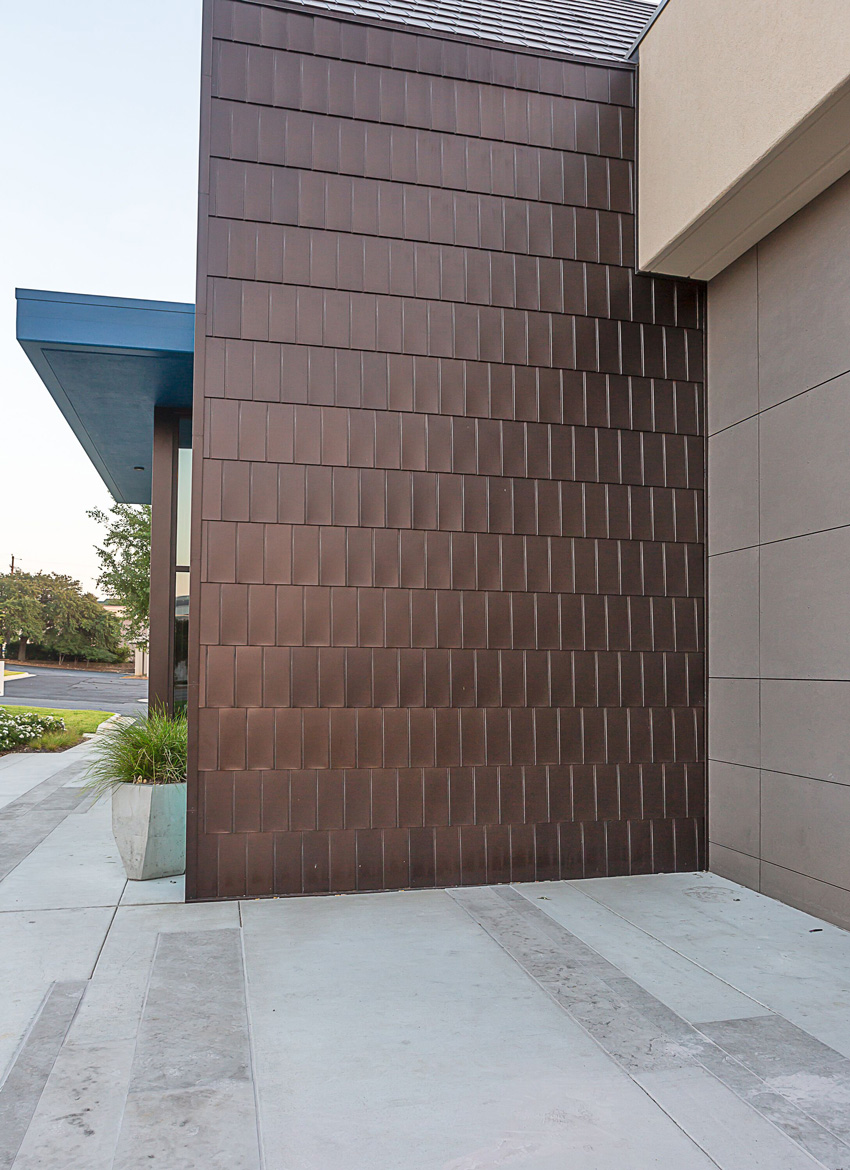
Photo: Tom Coplen
“We used metal tiles to create a continuous roof-to-wall transition at the entryways to refresh the gable feature and impart the upscale aesthetic desired by the client,” says project architect Eddie LaCroix.
In addition to the metal tiles cladding the gabled roofs and walls at the entryways of the building, the flagship Southside Bank building features a standing-seam metal roof. The material was selected because of its longevity and natural complement to the metal-tile aesthetic. A special metal-to-metal joint was used where the standing-seam panels intersected with the metal tiles, making the installation of the two metal materials easy and straightforward.
Ultimately, the renovation of the flagship Southside Bank branch was a success, and the metal-tile treatment at the entryways has been so well received that it will be incorporated onto many other Southside Bank branches as the company continues its rebranding initiative.
Mitered Corners Deliver Prairie-Style Design
Another development in metal-panel technology now enables designers to create a cleaner corner aesthetic on facades with metal panels. A mitered corner refers to a corner where two metal panels are joined without a vertical metal trim piece. It allows designers to create a continuous and uninterrupted horizontal line that wraps around the building.
The mitered corner offered designers a useful solution when creating the newest branch of the Summit Credit Union in Muskego, Wisconsin, because it enabled the team to satisfy the somewhat divergent community guidelines of the Muskego City Planning Department and the corporate branding guidelines of Summit Credit Union.
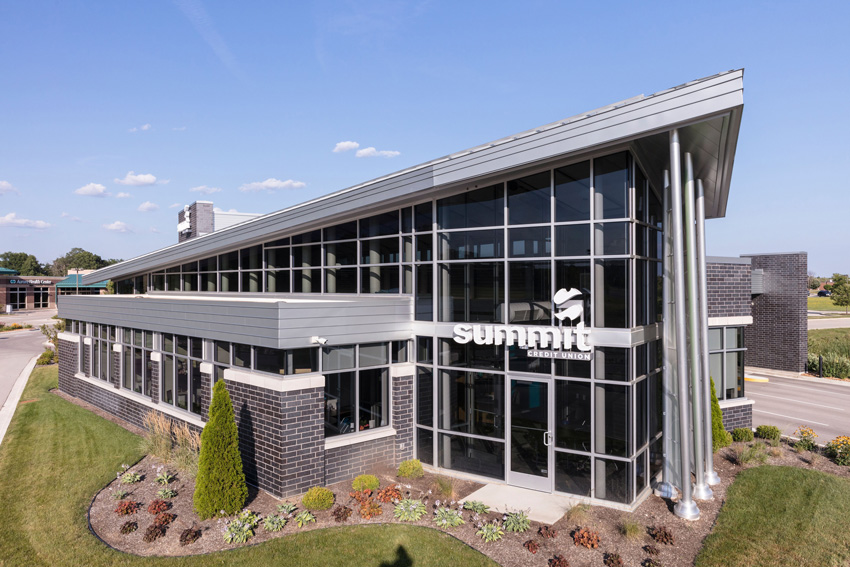
Photo: Scott Bell
Mitered corners, where two metal panels are joined at a corner without a vertical metal trim piece, helped designers achieve the horizontality necessary to satisfy the Prairie-style aesthetic required by the Muskego City Planning Department.
The Muskego City Planning Department required that buildings be constructed in Prairie-style architecture. Horizontal lines are a signature element of the style, with trim, bricks, and siding horizontally oriented in many of the homes built by or inspired by the father of the Prairie style, Frank Lloyd Wright. Cantilevered, flat roofs, rows of windows, and open, flowing interior layouts are other key features of this low-slung aesthetic.
“The credit union has a specific brand style that is youthful, forward-looking, welcoming, and cheerful with plenty of glass,” explains designer Peter Tan, AIA, NCARB, LEED AP, executive vice president and chief design officer at Strang. “The palette of materials for the Summit brand includes a manganese brick that is both black and silver at the same time. It has great depth to it, and the silver metal standing-seam roof and metal siding panels really complement this brick and the glass. The metal siding is a staple of the Summit branch aesthetic.”
The design team was tasked with delivering the Prairie-style look required by Muskego using the materials that had become synonymous with the Summit Credit Union brand. Mitered corners provided a solution that allowed the designers to achieve the horizontality necessary to satisfy the mandatory Prairie-style aesthetic. “When you have horizontal ribbed metal panels finished with J-trim, it interrupts the horizontal line, and the corner becomes visually enclosed,” Tan explains. “The mitered corners on this building created the unbroken horizontal lines we wanted. We absolutely needed to specify the mitered corners to meet the planning department’s requirement for true Prairie-style design.”
“With this building,” Tan says, “we gave the Muskego City Planning Department the Prairie style its community guidelines require and maintained the corporate branding the credit union wanted.”
Create Awe with Curved Roofs
Metal roofs and wall panels can also be curved to create a unique and dynamic building appearance, which is exactly how they were used in the design of the Discovery Center, the 100,000-square-foot centerpiece of a 50-acre park called Discovery Park of America located in Union City, Tennessee. The $100-million education center was primarily financed by the Robert E. and Jenny D. Kirkland Foundation. Kirkland, a retired businessman and investor, is a native son of Union City. He wanted to build a permanent venue in his hometown that would enhance education for children as well as adults. He also wanted visitors to be entertained.

Photo: HortonPhotoInc.com
The curved roof forms found on the Discovery Center were designed by Boston’s Verner Johnson to create a building that was futuristic, uplifting, and exuberant.
Boston-based Verner Johnson was hired for the design. The firm specializes in the planning and design of museums and science centers and has completed more than 200 projects around the world—but this project and its $300-per-square-foot budget would challenge its creative expertise. “Mr. Kirkland wanted the building to look like something no one in that region had seen before. He wanted the design and the exhibits to educate and elevate the aspirations of young people and the community,” explains Louis Sirianni, principal at Verner Johnson. “The design concept started with the idea of expressive, curving roof forms. We wanted the building to be futuristic and uplifting and exuberant. From the very beginning, the owner liked the idea of the curving forms, so once that was resolved, the metal standing-seam roof was an obvious choice. I’ve used a similar concept on other museum projects. I’ve always liked the texture, rhythm, and shiny, metallic appearance of this style of roof, and it’s economical, which was a factor given the tight budget we had on this job.”
The Discovery Center has two main areas: the Grand Hall and South Hall. The roofs of both halls are dramatically curved and clad in metal standing-seam panels. The panels on the Grand Hall were tapered as well as curved. “The deck slopes in three different directions—almost like a football shape,” explains Gordon Jones, the president and project manager of Ralph Jones Sheet Metal, the company that installed the panels on the roof. “There are about 400 panels on the roof, and no two are exactly alike. Every one of them is custom. This was one of the more complex jobs we’ve done in our 35-year history.”
Engage an Audience with Perforated Metal Panels
A new design trend gaining popularity is creating visual interest and intrigue on the facade with perforated aluminum walls panels. Perforated metal is layered over a non-perforated metal to create dimension and contrast. Beyond a unique aesthetic, architects can specify perforated metal to diffuse light, air, or sound and help control the immediate environment of the project. Typical applications include equipment screens, partitions, sign panels, parking decks, guards, interior acoustical applications, and enclosures of any kind. The perforation of a panel is designed in terms of the hole sizes, the spacing of the holes, and the total openness of the panel, which refers to the percentage of the panel that is actually open space. The perforated panels are available in any number of combinations, and the results have been award winning.
Memphis Ballet
A nationally acclaimed professional ballet company dreamed for 15 years of relocating to a more prominent location in Memphis, Tennessee. When it finally got its new 44,000-square-foot facility in the more centrally located Arts District, it wanted to uplift the community beyond dance and exercise with an inspiring community space filled with creativity and vibrancy. The resulting building was designed to engage the public in movement, wellness, culture, and community connection and was awarded an AIA 2018 Education Facility Design Award of Merit.
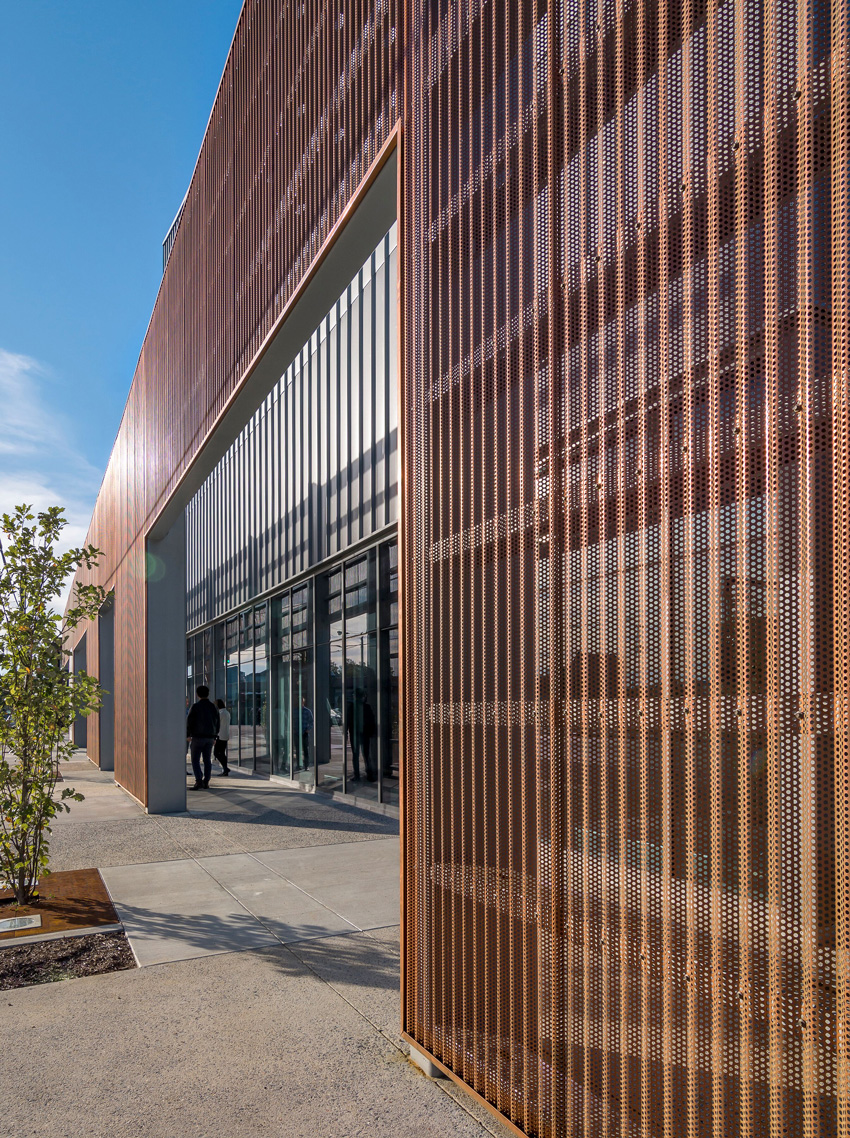
Photo: archimania
Perforated and solid copper panels frame a walkway that runs between the screen and the studio windows of the Memphis Ballet, inviting passersby to connect with the dancers inside.
“Dance and architecture share a focus on movement, space, and time,” explains Todd Walker, principal of archimania and project architect. “We wanted to make the project dynamic and energized.” To that end, the team created an exterior form comprised of layers of glass and contrasting metal panels (in copper and zinc) that resembles a music box, with the ideas of transparency and opening up to the community at the core of the design. Perforated and solid copper panels sit at the edge of the historic street and frame a 7-foot walkway between the signature screen and the studio windows. The lower, street-level portion of standing-seam panels are perforated and allow light and sight into the structure. Passersby can easily view the activities of the dancers inside.
“We liked the idea of breaking up the mass and scale of the large building by using two different materials. The copper screen looks more solid during the day and perforated at night when lights are on behind it. Plus, the varying angles of the sun makes the copper ever-changing, and the natural patina process will change it further over time as well,” Walker adds. “I think copper adds an element that may be more dynamic than any other metal material we have used.”
Create a Mosaic with Metal Panels
Metal panels are available in any number of vibrant standard or custom colors. Designers can use this material to create an impressive mosaic on a facade or as an exterior architectural element. Let’s take a look at a few of the ways that designers have used this material to make a statement.

Photo: Tom Coplen
The bold mosaic on the facade of the Alma Brewer Strawn Elementary School was constructed out of metal wall panels finished in cardinal red, colonial red, and burgundy.
At the new Alma Brewer Strawn Elementary School in Lytton Springs, Texas, the design team created a random pattern of bold metal wall panels to serve as a focal point in the design of the 58,000-square-foot facility. The 24-gauge vertical flush panels were finished in cardinal red, colonial red, and burgundy. “We liked the playfulness of the random red panels for this elementary-school application,” explains Brian Cotsworth, project manager at the firm Huckabee in Austin, Texas. “The metal panels also helped to bring down the scale of the building. The profiles really complement one another and blend well with the limestone on the lower level. It’s a progressive design that everyone really appreciates.”
Exterior wall panels in three different colors were also specified to clad a vertical rooftop extension of the auditorium and stage at the new Austin Independent School District Performing Arts Center. The 62,000-square-foot facility serves all Austin ISD schools and offers a 1,200-seat auditorium that hosts concerts and theatrical performances in a 250-seat black box theater. The project has received LEED Gold certification as well as a five-star rating from Austin Energy Green Building, its highest honor.
“One goal of the designers was to make the extension and the auditorium appear like one sculptural element,” explains Jessica Molter, project architect and principal at Pfluger Architects. To that end, the team set the tall structure away from the edge of the roof and clad it in an eye-catching mosaic of burgundy, colonial red, and terra cotta metal panels. “The decision to use metal on the rooftop extension was made early in the process,” Molter continues. “We thought the metal would give us the wow factor from a distance. We first considered using just a single color, but the consensus was that we needed something that stood out even more. That’s why we went with the nice three-color combination.”

Photo: Tom Coplen
At the Austin Independent School District Performing Arts Center, metal panels finished in three colors clad a vertical rooftop extension of the 1,200-seat auditorium.
The colors of the metal panels were selected to complement the rich tones of the maple used extensively on the interior of the auditorium and main-entry lobby. “The facade of the main lobby was mostly glass that revealed the vertical wood paneling inside,” Molter says. “We had a strong desire to design the building so that it would read as if the same wood material cut through to the outside. We wanted the upper, exterior material to appear as an architectural continuation of the maple paneling, an effect that is quite visible at night when the lobby is illuminated.”
Ultimately, metal panels can be used from top to bottom on a home or commercial building to deliver high-performance, efficiency-enhancing, weather-resistant exteriors with high-caliber flair. Metal roofs can stay cool to the touch under the blazing sun, while helping to keep the interior air and local environmental temperatures low. Metal wall panels can be used to create vibrant and eye-catching facades that inspire or spark the imaginations of passersby. Used as either a roof or wall, metal panels offer designers flexible and functional solutions that can help them achieve their most dramatic creative visions.
Jeanette Fitzgerald Pitts has written nearly 100 continuing education courses exploring the benefits of incorporating new building products, systems, and processes into project design and development.
